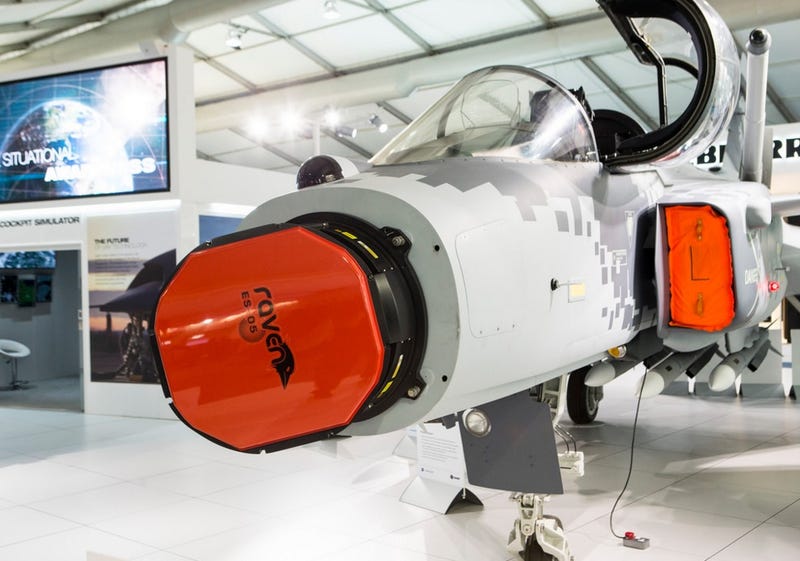The Patria NEMO 'Mortar Boat' Is Small And Fast With A Huge *** Gun
Littoral warfare is all the rage these days, being able to snuggle in around shoals and the muddy water of contested territory and vanquish your enemy with speed and overwhelming force. That exact mission is what Finland's Patria NEMO 120mm mortar boat is all about. It is a small and fast shallow draft vessel with one huge ***, surgically accurate gun.
The NEMO, which stands for 'NEw MORrtar,' is a fully automated, gyro stabilized, breach-loading 120mm mortar turret system. In the past, originally it was designed for land-based applications, now it has gone to sea. It can fire while the ship is rolling and pitching, even at high speed, and it is ridiculously accurate.
NEMO boasts a range beyond that of anti-tank missiles, a weapon that is becoming a staple when it comes to countering small boat swarms. The gun's stated range is over 10km, and its barrel can traverse -3 to +85 degrees while spouting off 7 shots a minute continuously or a three round burst in just 12 seconds.
The base for this mini battleship of sorts is Alutech Marine's Watercat M12 landing craft, which is an enlarged and more powerful version of the
JurmoClass landing craft. The M12 is a super maneuverable and very stable fast landing craft that uses twin 525 kW marine diesel engines and Rolls-Royce FF410S water jets to sling it through even very shallow water at speeds approaching 45 knots.
The boat's bow ramp is hydraulically powered, allowing access to rapidly load and offload 16 troops, all of which sit on impact dampened seats within the boat's Kevlar lined bow-cocoon. Another eight troops can be held above deck. In the Patria NEMO's case, this space is used for accessing the automatic gun turret and space left unused by the big gun can be utilized for storing additional 120mm shells and other cargo. The M12 also has a lavatory and small galley, so extended missions are not a problem.
In addition to the big gun, the M12 has a pair of 50 cal machine guns for self defense, but there is no reason why these could not be replaced with smaller 7.62 machine guns, mini-guns or even automatic grenade launchers.
The idea is that the Patria Nemo can provide hard hitting, medium-range indirect fire support from places where larger surface combatants could never operate from. For instance, if a special forces team were operating deep in a reverine environment, the Patria Nemo could be almost ten kilometers away, hidden deep in an inlet or tributary of a river, ready to rain down hell on the enemy at a moments notice. Then, in a 'run and gun,' direct fire combat environment, the Patria Nemo can rapidly engage multiple fast boats, even at very close range, providing a robust anti-boat swarming capability.
Being that it fires a highly adaptable mortar round, different ammo variations with different fusing options can be selected based on the target. For instance, an air-burst round could probably knock out a small boat without even having to nail it directly, as a burst of explosive shells detonating a few dozen feet above the waterline would result in a mission kill.

For clearing beaches or providing sustained fire support, rounds fired in succession can sanitize large areas of enemy personnel. This can be accomplished via programming the fire support plan into the NEMO fire-control system's user interface, or via coordinates that can be data-linked to the boat via forward spotters. If a bunker or hardened vehicle needs to be targeted, an armor piercing high-explosive (HEAT) round salvo could be fired at it. In other words, the 120mm 'smart' mortar is like the Swiss Army Knife of highly mobile fire support, it can quickly adapt to the situation at hand, for situations that require both within line of sight and beyond line of sight attacks.

The Patria NEMO was originally tested on a larger craft, the Naval Fast Patrol Boat, in its harder hitting, twin-barrel AMOS form. Yet the low-cost of operation, maneuverability, small target size and the M12's ability to operate 'up river' in areas where nearly no draft exists, made it a more attractive surrogate for the big single barreled 120mm NEMO turret.
This heavily armed jet boat's tactical attractiveness has already panned out in some sales. The Finnish Navy has bought the system and so has the UAE. This makes total sense as the boat's unique abilities are incredibly well suited to the tactical challenges of Persian Gulf. The land-based NEMO system also has many interested parties and a few sales already under its belt, making the water-borne version that much more attractive to potential operators of both systems.
The M12/NEMO system seems incredibly well suited for riverine special operations forces here in the US. Being able to support a special forces team up river with their own dedicated indirect fire support would be a very valuable capability. With this in mind, it wouldn't be surprising if these big gun toting jet boats start showing up in the US, with US Navy SWCCs at their controls.





































































































